 |
 |
 |
 |
Uranium Resources as Co- and By-products of Polymetallic, Base, Rare Earth and Precious Metal Ore Deposits
IAEA TECDOC, 2018, 168 p.
This publication highlights the potential presence of uranium in ore deposits that are not commonly thought of as uraniferous and therefore highlights potential additional sources of uranium supply. It also provides insights into potential legacy mine waste issues for such deposits if the uranium is not extracted. The publication also outlines various historical mining |
and processing approaches, supported by case studies of each deposit type. The appendix to this publication includes a detailed IAEA deposit classification of uranium deposits and their global distribution, and shows for comparison purposes the equivalent distribution of other deposit types not traditionally considered as uranium deposits (but nevertheless with uranium extraction potential).
|
 |
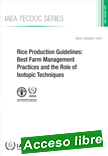 |
Rice Production Guidelines: Best Farm Management Practices and the Role of Isotopic Techniques
IAEA TECDOC, 2018, 140 p.
This publication is intended to enhance rice production and provides information on best management practices. The role of isotopic techniques to quantify nitrogen use efficiency is addressed and information presented to support a better understanding of the pathways of greenhouse gases emission. The publication informs the reader on improved rice |
varieties and sustainable cultivation practices from a wide range of Asian countries. This will enable national research and development staff to select and test these varieties and practices in farmers’ fields to promote improved rice varieties and crop management practices in the respective countries. By using these improved crop management methods, farmers can improve the productivity and profitability of rice crops through the adoption of locally adapted ‘best’ rice varieties, thereby protecting the local environment.
|
 |
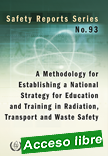 |
A Methodology for Establishing a National Strategy for Education and Training in Radiation, Transport and Waste Safety
IAEA Safety Reports Series, 2018, 66 p.
This publication provides Member States with a detailed methodology to establish a national strategy for education and training in radiation, transport and waste safety, in order to build competence in a sustainable and timely manner. Guidance is provided on assessing education and training
|
needs, giving consideration to the national legal and regulatory framework for education and training, and the current and future facilities and activities; designing the national education and training programme based on the needs; and optimizing national resources to complement external assistance. A practical example of the application of the methodology is generated for a hypothetical country, outlining the chronological sequence of the actions to be taken, their timeframe, including the role and contribution from the different national stakeholders. This methodology has been tested in the field during 20 regional workshops attended by about 300 participants from more than 80 Member States.
|
 |
 |
WANO Review 2017
World Association of Nuclear Operators (WANO), October 2017, 17 p.
The 2017 WANO Review includes information on the WANO programme restructure, detailing what has changed and what remains the same; and a feature article (available in nine languages) on WANO's revised long-term plan, Compass.
|
|
 |
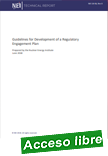 |
Guidelines for Development of a Regulatory Engagement Plan
Nuclear Energy Institute (NEI - US), June 2018, 57 p.
A Regulatory Engagement Plan (REP) can be a valuable tool for enhancing communication between a prospective applicant or pre-applicant1 and the Nuclear Regulatory Commission (NRC) staff. It can be used to document the agreement between the applicant and NRC staff regarding licensing approach, resolution of issues, schedule expectations, and |
other topics. The primary intent of such a document is to reduce regulatory uncertainty by establishing such agreements as early in the regulatory process as possible.
|
 |
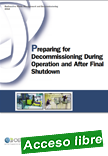 |
Preparing for Decommissioning during Operation and after Final Shutdown
Nuclear Energy Agency (NEA), 25/05/18, 164 p.
The transition from an operating nuclear facility to the decommissioning phase is critical in the life cycle of every facility. A number of organisational and technical modifications are needed in order for the facility to meet new objectives and requirements, and a certain number of activities must be initiated to support the transition and preparation for the dismantling of the facility. Thorough preparation and planning
|
is key for the success of global decommissioning and dismantling projects, both to minimise delays and undue costs and to ensure a safe and efficient decommissioning process.
The aim of this report is to inform regulatory bodies, policy makers and planners about the relevant aspects and activities that should begin during the last years of operation and following the end of operation. Compiling lessons learnt from experiences and good practices in NEA member countries, the report supports the further optimisation of transition strategies, activities and measures that will ensure adequate preparation for decommissioning and dismantling.
|
 |
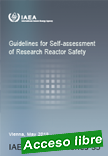 |
Guidelines for Self-assessment of Research Reactor Safety
IAEA Services Series, 2018, 92 p.
The main objective of this publication is to provide guidelines for a research reactor operating organization to perform a self-assessment of the safety management and safety performance of its facility and help to identify gaps between the current situation and conformance with the requirements in IAEA Safety Standards Series No. SSR-3, Safety of Research Reactors. Research reactor operating organizations can use |
these guidelines at any time to support self-assessments done in accordance with the organization’s integrated management system.
These guidelines also serve as a tool for an organization to prepare to receive an INSARR mission. An important result of this is the opportunity for an operating organization to identify focus areas and make safety improvements in advance of an INSARR mission, thereby increasing the effectiveness of the mission and efficiency of the INSARR service.
A second objective of the publication is to provide information and guidelines for Member States, regulatory bodies and operating organizations to perform self-assessment of their application of the provisions of the Code of Conduct on the Safety of Research Reactors. This publication includes a mapping of the safety requirements in Safety of Research Reactors (and other IAEA safety requirements) to the provisions of the Code to assist States, regulatory bodies and operating organizations with developing actions plans to enhance application of the Code.
|
 |
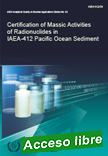 |
Certification of Massic Activities of Radionuclides in IAEA-412 Pacific Ocean Sediment
IAEA Analytical Quality in Nuclear Applications Series, 2018, 68 p.
The accurate and precise determination of radionuclide concentrations in marine samples is an important aspect of marine radioactivity assessment and the use of radionuclides in studies of oceanographic processes. To address the problem of data quality, the IAEA Environment Laboratories |
(IAEA-EL) in Monaco regularly conduct characterization studies aimed to assign values to reference materials for radionuclides and other components in different matrices of marine samples as an integral part of the Sub-programme IAEA Reference Products for
Science and Trade.
The sediment was collected during the "IAEA ´97 Pacific Ocean Expedition" on board of research vessel Bosei Maru, which took place from 21 October to 20 November 1997, with sampling stationsbat Bikini and Eniwetok atolls. The Japan Meteorological Agency and Tokai University were among the collaborating institutes.
As the sample was collected in the Pacific Ocean, elevated levels of long lived anthropogenic radionuclides (such as 137Cs) were expected due to the influence of historical atmospheric nuclear weapon tests. Participants were informed that the expected activities for anthropogenic radionuclides would be in the ranges:
Gamma emitters 0.1 0.5 kBq kg-1
Transuranic 0.01 0.5 Bq kg-1
This report describes the results on anthropogenic and natural radionuclide determinations in sediment obtained from 27 selected laboratories (including IAEA-EL and five laboratories belonging to CELLAR1) which will allow the IAEA-EL to produce a new certified reference material IAEA-412 following ISO guidelines.
|
 |
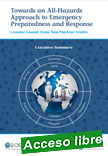 |
Towards an All-Hazards Approach to Emergency Preparedness and Response: Lessons Learnt from Non-Nuclear Events
Nuclear Energy Agency (NEA), 12/01/18, 104 p.
Over the years, member countries from the OECD Nuclear Energy Agency (NEA) have developed effective emergency preparedness and response (EPR) arrangements for nuclear facilities and off-site response organisations. These arrangements have usually been tested through exercises involving the facility and off-site response organisations.
|
EPR arrangements have thus been enhanced as necessary to include lessons learnt from nuclear emergency exercises, nuclear power plant accidents such as the accident at Fukushima Daiichi and changes to international guidance.
While nuclear power plant accidents are very rare, industrial non-nuclear events and natural disasters occur more frequently and can have a potentially large impact on populations and on widespread geographical areas. As a result of these events, populations may be required to take part in protective actions such as sheltering, evacuation and the restriction of food supplies. Research on these types of non-nuclear events and natural disasters has been extensive and has led to an understanding of factors that have supported the effectiveness of response activities, as well as those factors that may have degraded the response. This type of information can be used to enhance existing preparedness efforts for nuclear power plants, for other industrial facilities and for natural disasters in an “all-hazards” framework.
In recognition of the importance of an all-hazards approach to preparedness and
response, the International Atomic Energy Agency (IAEA) General Safety Requirements (GSR No. 7), Preparedness and Response for a Nuclear or Radiological Emergency (IAEA, 2015), encourage, to the extent practicable, the inclusion of the emergency management system in an all-hazards framework. The OECD Council similarly supports the integration of a nuclear emergency management system into a comprehensive, all-hazards and transboundary approach to country risk governance as a foundation for enhancing national
resilience and responsiveness. Contributions to this report support the value of such an all hazards approach to EPR.
Executive summary: http://www.oecd-nea.org/rp/pubs/2018/7436-all-hazards-epr-es.pdf
|
 |
 |
Establishing the Infrastructure for Radiation Safety - Safety Guide
IAEA Safety Standards Series, 2018, 85 p.
The objective of this Safety Guide is to provide guidance on the establishment of the national radiation safety infrastructure that meets the IAEA safety standards. It provides recommendations, in the form of actions, on meeting the relevant Safety Requirements in an effective and integrated manner while taking specific national circumstances into full consideration. This Safety Guide does not diminish the
|
application of, or provide a synopsis of or a substitute for, the IAEA Safety Fundamentals and Safety Requirements publications or other associated Safety Guides. Rather it sets out a holistic approach to the establishment of the national radiation safety infrastructure and provides advice for the application of IAEA safety standards for both, States having essentially no elements of the radiation safety infrastructure in place, and those that already have some.
|
 |
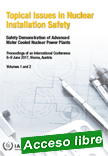 |
Topical Issues in Nuclear Installation Safety - Safety Demonstration of Advanced Water Cooled Nuclear Power Plants - Proceedings of an International Conference Held in Vienna, 6–9 June 2017
IAEA Proceedings Series, 2018, 656 p.
This publication presents the proceedings of the international conference on topical issues in nuclear safety. The conference provided a unique forum to present and discuss the latest approaches, advances and challenges in the demonstration
|
of the safety of nuclear power plants that are planned to be licensed and constructed in the near future, in particular those using water cooled reactors, including small and medium sized or modular reactors. The proceedings include the key insights and recommendations summarized by the Conference President, the executive summary of the conference including the key outcomes and recommendations attained together with the full conference programme.
|

|
|
|
 |
Preparación y Respuesta para Casos de Emergencia Nuclear o Radiológica
OIEA Requisitos de Seguridad Generales, 2018, 150 p.
En la presente publicación se establecen los requisitos necesarios para lograr un nivel adecuado de preparación y respuesta para casos de emergencia nuclear o radiológica. La aplicación de tales requisitos debe servir también para mitigar las consecuencias de una emergencia nuclear o radiológica en caso de que, pese a los esfuerzos
|
desplegados para prevenirla, esta se acabe produciendo.
|
| |
| |
|
|
| |
| |
|
|
| |
| |
|
|
|
